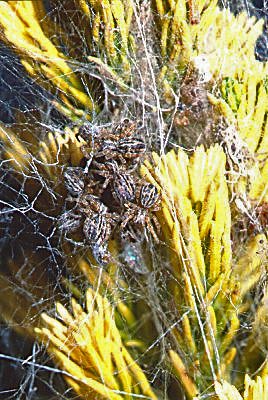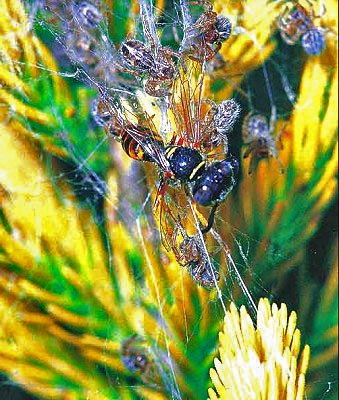|
Stegodyphus (social spiders)
Life
> Eukaryotes
>
Opisthokonta >
Metazoa
(animals) > Bilateria > Ecdysozoa > Panarthropoda > Tritocerebra >
Arthropoda > Arachnomorpha > Cheliceriformes > Chelicerata > Euchelicerata
> Arachnida > Araneae
> Araneomorpha > Family: Eresidae
Stegodyphus, commonly called social
spiders, occur in Africa and South
America with 8 species occurring in South Africa. This genus has the typical
Eresidae feature and the colour varies from shades of grey to brown with black
markings and yellow infusions. The flat face has 2 contiguous (so near that they
touch) black triangular markings meeting medially. Females of the social species
are 8-14 mm in length and males slightly smaller. Spiders of the solitary
species are normally larger, ranging from 6-23 mm in length.
Most species are solitary except the social Stegodyphus
domicola that occurs in most of southern Africa, and Stegodyphus
mimosarum that occurs in the eastern regions. The latter two species are the
most commonly encountered resulting in the misleading common names, community
nest or social spiders, being used to describe the entire genus.
Stegodyphus could in fact have been called
the tennis net spider due to its hackle web that is stretched between two
points. The hackled appearance is due to the cribellate (teased) silk used. At
one end of the web is a small ball-shaped nest attached to the vegetation, about
a metre above the ground. In the Western Cape these webs are found in the Fynbos
while in the Bushveld, the Acacia trees are used. However, fences, poles and other
structures are also used. A new nest is started by as few as two spiders
(usually female) that leave their original nest. As the colony increases, the
nest is enlarged by successive generations. The nest includes mostly female and
young; the latter living in chambers within the nest, much like a block of
flats. The nest can be used for many years and can house in excess of 100
spiders. Birds often use the silk to line their nests.
There is a variation of adult size as Stegodyphus
mature at different moult stages ( 7 to 10 stages) and adults continue to moult
even after maturity. Mature spiders in smaller colonies tend to be larger than
mature spiders in larger colonies.

|

|
| Stegodyphus sp. |
Stegodyphus sp. with
wasp prey. |
When prey lands in the web, a few spiders rush
out, overpower and collectively drag it to a nest chamber where they will be
joined by other spiders for the feast. The larger the prey, the larger the
number of spiders that assist with its capture and removal.
Text by Norman Larsen ©. |
